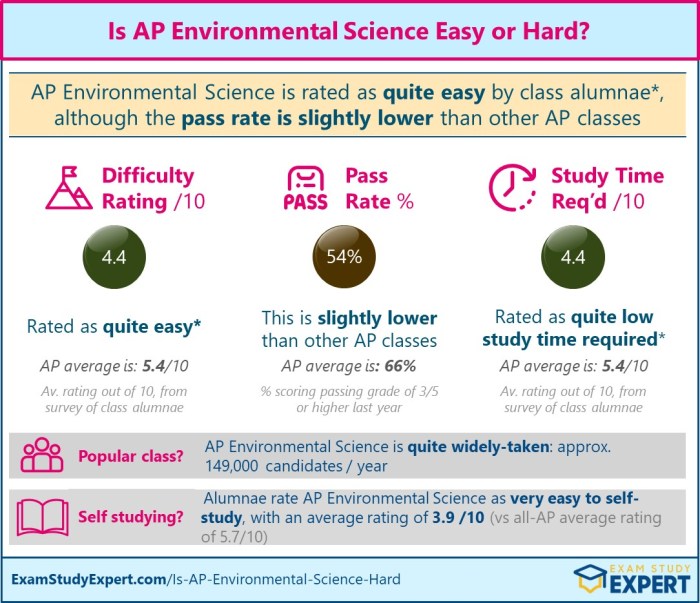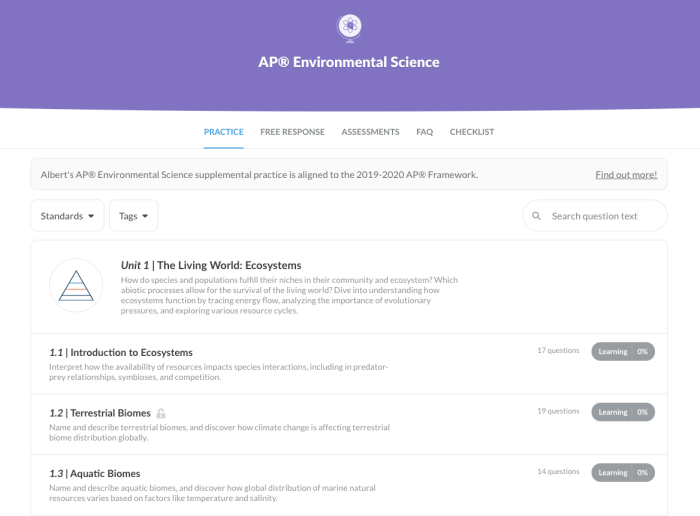Ap environmental science unit 5 test – Embarking on a journey through AP Environmental Science Unit 5, we delve into the intricacies of ecosystems, biodiversity, and ecological processes. This unit unravels the complex web of interactions that shape our planet’s natural systems, providing a comprehensive understanding of the delicate balance that sustains life.
From the foundational concepts of ecosystems and biodiversity to the intricate dynamics of population and community ecology, this unit equips learners with a holistic perspective on the natural world. We explore the flow of energy and nutrients through ecosystems, examining the vital roles of producers, consumers, and decomposers.
The unit culminates in an examination of conservation biology, highlighting the threats to biodiversity and the strategies employed to preserve our planet’s ecosystems and species.
Unit Overview
Unit 5 of AP Environmental Science delves into the complexities of human population dynamics and their profound implications for environmental sustainability. It explores the intricate interplay between population growth, resource consumption, and environmental degradation, equipping students with a comprehensive understanding of the challenges and opportunities facing humanity in the 21st century.
Key concepts and topics covered in this unit include:
- Population growth patterns and their underlying drivers
- Demographic transitions and their environmental consequences
- Carrying capacity and its implications for sustainable development
- Population policies and their effectiveness in addressing environmental issues
- The role of education, healthcare, and economic development in mitigating population growth
- The ethical dimensions of population control and sustainable development
Ecosystems and Biodiversity

Ecosystems, the fundamental units of ecology, encompass intricate networks of living organisms interacting with their physical environment. They consist of biotic components (living organisms) and abiotic components (non-living elements). Understanding ecosystems and biodiversity is crucial for comprehending the dynamics and resilience of our planet.
Concept of Biodiversity
Biodiversity, or biological diversity, refers to the variety and variability of life forms on Earth. It encompasses the diversity of species, genes, and ecosystems. Biodiversity plays a vital role in ecosystem functioning, providing essential services such as nutrient cycling, water purification, and climate regulation.
Types of Ecosystems, Ap environmental science unit 5 test
Earth’s ecosystems exhibit a wide range of characteristics and are broadly classified into two major types: terrestrial and aquatic.
- Terrestrial Ecosystems: These ecosystems occur on land and include diverse habitats such as forests, grasslands, deserts, and mountains. Each terrestrial ecosystem is characterized by unique plant and animal communities adapted to specific environmental conditions.
- Aquatic Ecosystems: These ecosystems occur in water bodies and encompass a wide range of habitats, including freshwater ecosystems (e.g., lakes, rivers, wetlands) and marine ecosystems (e.g., oceans, coral reefs). Aquatic ecosystems support diverse aquatic organisms, from microscopic plankton to large marine mammals.
Population Ecology

Population ecology investigates the dynamics and characteristics of populations, including their size, density, distribution, and growth patterns. It explores the factors influencing population fluctuations and their ecological implications.
Factors Affecting Population Growth and Decline
- Birth and Death Rates:These rates determine the overall population growth or decline. Factors like availability of resources, predation, and disease can influence these rates.
- Immigration and Emigration:Movement of individuals into and out of a population can significantly impact its size and growth.
- Environmental Conditions:Factors such as temperature, rainfall, and habitat availability can influence population growth and decline.
Population Distribution Patterns
Populations can exhibit various distribution patterns:
- Clumped:Individuals are concentrated in specific areas due to factors like resource availability or social interactions.
- Uniform:Individuals are evenly spaced throughout the habitat, often due to territoriality or competition for resources.
- Random:Individuals are distributed without any discernible pattern, typically in habitats with abundant resources.
These distribution patterns have ecological implications, such as influencing species interactions, resource utilization, and predator-prey dynamics.
Community Ecology
Community ecology examines the interactions between species within a defined geographic area. It focuses on how these interactions influence the distribution, abundance, and diversity of species.
Species Interactions
Species within communities engage in various interactions that shape their ecological niches and overall dynamics:
- Competition: Occurs when species utilize the same limited resources, such as food or habitat, leading to reduced growth or survival.
- Predation: Involves one species (predator) consuming another (prey), influencing prey populations and predator feeding patterns.
- Symbiosis: A close relationship between two or more species where one or both benefit, including mutualism (both species benefit), commensalism (one species benefits while the other is unaffected), and parasitism (one species benefits at the expense of the other).
Keystone Species
Keystone species are species that have a disproportionately large impact on their community relative to their abundance. Their removal or decline can lead to significant changes in community structure and ecosystem function.
Species Loss and Community Dynamics
The loss of species from a community can disrupt ecological interactions and have cascading effects:
- Trophic cascades: The loss of a predator can lead to an increase in prey populations, which in turn can affect the abundance of plants.
- Functional redundancy: Some species may perform similar ecological roles, and their loss can be compensated by other species with similar functions.
- Community resilience: The loss of keystone species or a large number of species can reduce community resilience and its ability to recover from disturbances.
Energy Flow and Nutrient Cycling
Energy flow and nutrient cycling are fundamental processes that sustain life on Earth. Energy flows through ecosystems in a one-way direction, from producers to consumers to decomposers, while nutrients cycle through ecosystems in a continuous loop. These processes are essential for the functioning of ecosystems and the survival of all organisms.
Role of Producers, Consumers, and Decomposers
Producers, such as plants and algae, use sunlight to convert inorganic matter into organic matter through photosynthesis. This organic matter is then used by consumers, such as animals and fungi, as a source of energy. Decomposers, such as bacteria and fungi, break down dead organisms and waste products, releasing nutrients back into the environment.
Major Nutrient Cycles
The major nutrient cycles include the carbon cycle, the nitrogen cycle, and the phosphorus cycle.
- Carbon Cycle: Carbon dioxide is released into the atmosphere through respiration and decomposition. Plants use carbon dioxide for photosynthesis, and animals consume plants. Carbon is also stored in the ocean and in fossil fuels.
- Nitrogen Cycle: Nitrogen is essential for protein synthesis. Nitrogen-fixing bacteria convert atmospheric nitrogen into a form that can be used by plants. Animals consume plants, and nitrogen is passed up the food chain. Decomposers release nitrogen back into the soil.
- Phosphorus Cycle: Phosphorus is essential for energy transfer and bone formation. Phosphorus is mined from the Earth’s crust and used in fertilizers. Phosphorus is also released into the environment through erosion and decomposition.
Impacts of Human Activities
Human activities can have a significant impact on energy flow and nutrient cycling.
- Deforestation: Deforestation reduces the amount of organic matter available for decomposition, which can lead to a decrease in nutrient cycling.
- Fossil Fuel Combustion: Fossil fuel combustion releases carbon dioxide into the atmosphere, which can lead to climate change.
- Agriculture: Agriculture can lead to nutrient pollution, which can have a negative impact on water quality.
Conservation Biology

Conservation biology is the scientific study of the preservation, protection, and restoration of biodiversity. It aims to prevent the extinction of species and maintain the integrity and function of ecosystems.
The main goals of conservation biology include:
- To protect and restore species and their habitats.
- To maintain and enhance biodiversity.
- To prevent the extinction of species.
- To ensure the sustainable use of natural resources.
Threats to Biodiversity
Biodiversity is threatened by various human activities, including:
- Habitat loss and degradation
- Overexploitation of resources
- Pollution
- Invasive species
- Climate change
Conservation Strategies
To address the threats to biodiversity, various conservation strategies are employed, including:
- Protected areas (e.g., national parks, wildlife refuges)
- Habitat restoration and management
- Species reintroduction and captive breeding programs
- Sustainable resource use
- Public education and awareness
Role of Protected Areas
Protected areas are designated areas of land or sea that are managed to conserve biodiversity. They play a crucial role in preserving ecosystems and species by providing:
- Habitat protection
- Buffer zones against human activities
- Opportunities for scientific research and monitoring
- Ecosystem services (e.g., water purification, carbon sequestration)
Other Conservation Measures
In addition to protected areas, other conservation measures include:
- Habitat corridors to connect fragmented habitats
- Conservation easements to restrict development on private land
- Species recovery plans to protect endangered species
- International agreements (e.g., Convention on Biological Diversity)
Q&A: Ap Environmental Science Unit 5 Test
What are the key concepts covered in AP Environmental Science Unit 5?
Unit 5 focuses on ecosystems, biodiversity, population ecology, community ecology, energy flow and nutrient cycling, and conservation biology.
What are the different types of ecosystems discussed in the unit?
The unit explores various types of ecosystems, including forests, grasslands, deserts, aquatic ecosystems, and urban ecosystems.
How does the unit address the importance of biodiversity?
The unit emphasizes the significance of biodiversity for ecosystem functioning, stability, and resilience.